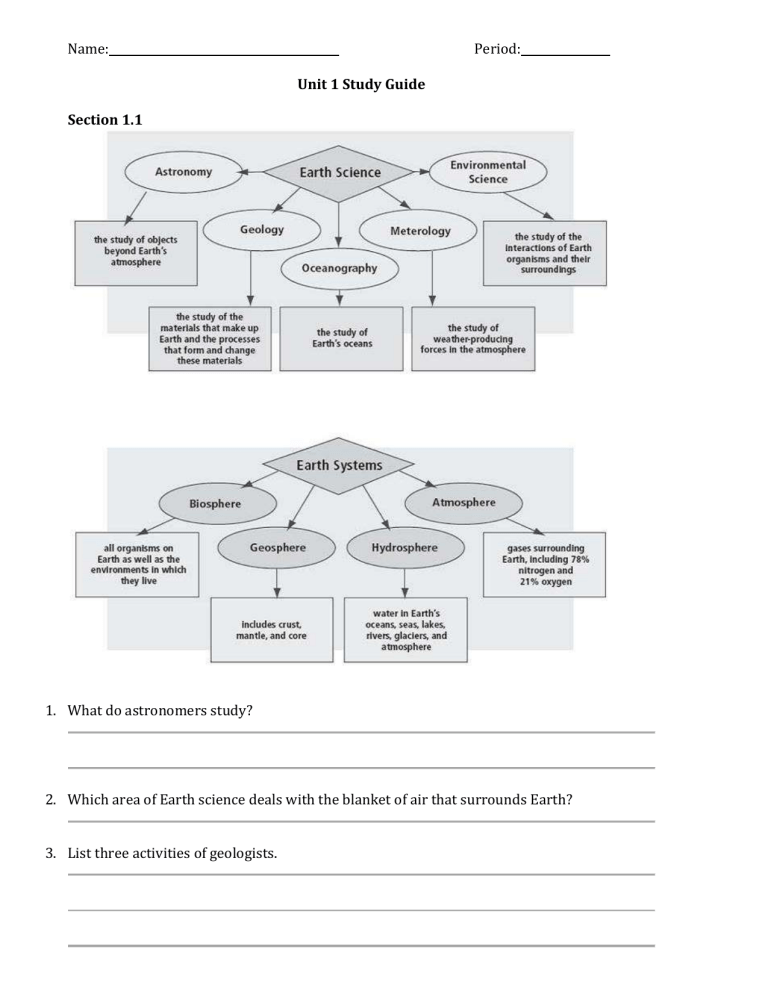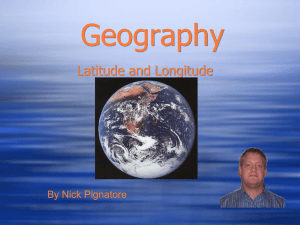Earth Science Unit 1 Study Guide: Astronomy, Geology & Maps

Name:
Section 1.1
Unit 1 Study Guide
Period:
1.
What do astronomers study?
2.
Which area of Earth science deals with the blanket of air that surrounds Earth?
3.
List three activities of geologists.
4.
Which Earth scientists study the properties and inhabitants of saltwater bodies?
5.
What are the parts of Earth's geosphere?
6.
Contrast the atmosphere with the biosphere.
7.
What percentage of the hydrosphere exists as salt water? What percentage exists as freshwater?
8.
Which two gases make up 99 percent of the gases in the atmosphere? Which gas is more abundant?
9.
What are the components of the biosphere?
Directions: Use the terms below to identify of the major area of Earth science that studies each subject. Each term can be used more than once.
Astronomy
Oceanography
Meteorology Geology
Environmental science
____________________ 10. Physical and chemical properties of the oceans
____________________ 11. Objects beyond Earth's atmosphere
____________________ 12. Materials that make up Earth
____________________ 13. Forces and processes that produce weather
____________________ 14. Earth's neighbors, distant stars, and other cosmic bodies
____________________ 15. Rocks, glacial movements, and clues to Earth's history
____________________ 16. Creatures that inhabit salty water
____________________ 17. Interactions of organisms and their surroundings.
Directions: Circle the letter of the choice that best answers the question.
18.
What subspecialty of Earth science studies patterns of weather over a long period of time? a. geochemistry b. climatology c. soil science d. paleontology
19.
Geochemistry is the study of which of the following? a. habitats of organisms b. effects of internal processes on Earth's surface c. Earth's composition and processes d. how the moon and stars affect people's lives
20.
What subspecialty of Earth science studies ancient environments? a. paleontology b. geochemistry c. marine geology d. climatology
21.
Which of the following might an environmental scientist study?
22.
In what field do scientists study the processes that change Earth's composition? a. climatology b. astrophysics c. geochemistry d. paleontology a. earthquakes and mountain building b. the remains of organisms that once lived on Earth c. the kinds of matter in the universe d. how organisms interact with each other and their environments
Directions: Use the map below to answer questions
23.
What is the latitude and longitude (to the nearest degree) of the following cities?
Kansas City Philadelphia
Reno Minneapolis
24.
Use the map to find the names of cities with the following coordinates.
30 N, 96 W 35 N, 95 W
26 N, 80 W 42 N, 88 W
25.
How many kilometers north of the equator is Washington, D.C.? Show your work.
26.
How many kilometers south of the north pole is Portland? Show your work.
27.
Approximately how far north of Houston is Kansas City? Use degrees of latitude to calculate your answer. Show your work.
28.
Which city is closer to Greenwich, England: Los Angeles or Xi'an, China (34°N, 109°E)?
Explain your answer.
29.
How many degrees of longitude separate Las Vegas from the International Date Line, which is at 180° longitude?
Mapping Our World
SECTION 2.1 Latitude and Longitude
Directions: Match the definition in Column A with the term in Column B.
Column A Column B
________ 1. Science of mapmaking
________ 2. Imaginary line that separates Earth into northern and southern hemispheres
________ 3. Distance in degrees north or south of the equator
________ 4. Distance in degrees east or west of the prime meridian
________ 5. Reference point for longitude that passes through Greenwich, England, and represents 0° a.
b.
c.
d.
e.
prime meridian longitude
cartography equator latitude
Directions: In the space at the left, write true or false.
_______________ 6. The equator is located halfway between the north pole and the prime
meridian.
_______________ 7. Lines of latitude run parallel to the equator.
_______________ 8. The equator is at 180° latitude.
_______________ 9. The south pole is at 90° south longitude.
_______________ 10. One degree of latitude is equivalent to about 111 km on Earth's surface.
_______________ 11. Each degree of latitude is divided into 360 minutes.
_______________ 12. Lines of longitude are also called meridians.
_______________ 13. The prime meridian is the reference line for latitude.
_______________ 14. Points east of the prime meridian are located between 0° and 180°
east longitude.
_______________ 15. Lines of longitude are semicircles that extend from the north pole to the south pole.
_______________ 16. Each degree of longitude corresponds to about 111 km at the north pole.
_______________ 17. All meridians converge at the poles.
Directions: Use the map grid to answer the following questions.
18.
What is the latitude of point A?
19.
Which two points have the same latitude? What is that latitude?
20.
What is the longitude of point B?
21.
Which two points have the same longitude? What is that longitude?
22.
What are the coordinates of point C?









